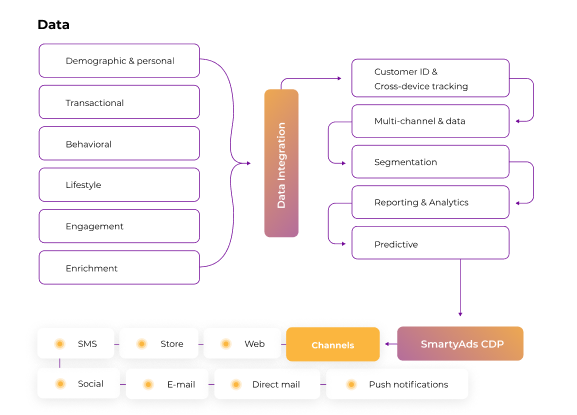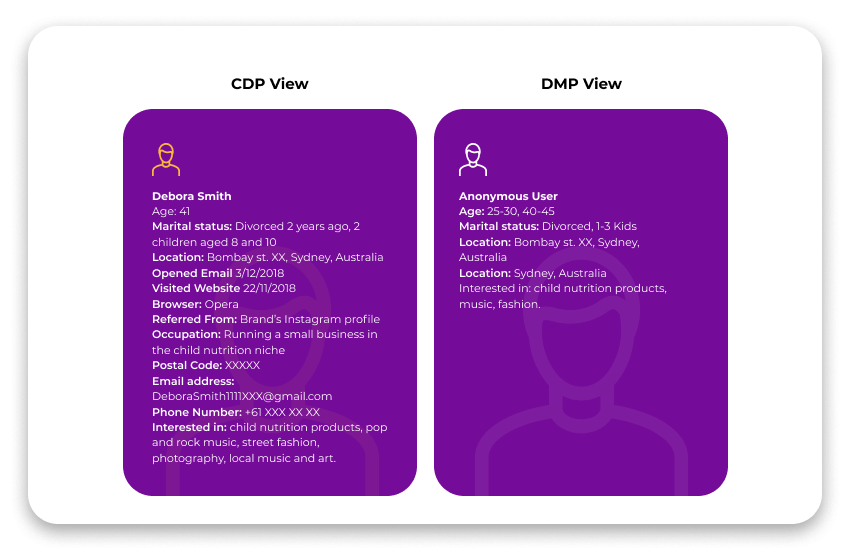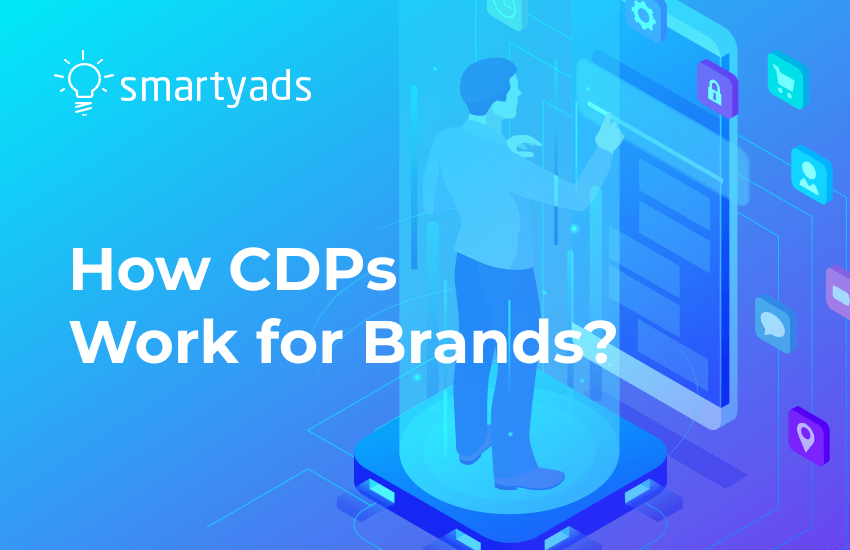What is CDP? Is it just a new trendy word in marketing automation or a must-have tool for advertisers of all kinds? Let’s figure out how it works and uncover all the benefits it brings to marketers and advertisers.
The Definition of a CDP or What Does CDP mean
Customer data platform (CDP) is a marketer-managed tool that collects personally identifiable information (PII) from online and offline sources, creating a unified customer database with single-view customer profiles.

The main purpose of a CDP is not solely customer data storage. CDPs are more about smart data usage aimed at precise customer identification, individual ad message delivery, and creating a stronger bond between brand and customer.
The Reasons Why Marketers Need Customer Data Platforms
A customer management platform became a household word due to mass investments and acquirements of such. During the summer funding campaign, Reltio raised over $45M, while Salesforce reported about the Datorama CDP acquisition valued at $800M.
However, the main reason for the fast-track growth of CDPs is a global focus on marketing personalization. Figures provided by Statista confirm that this trend was initiated by consumers themselves: 76% of them prefer dealing with businesses that offer personalized online experiences. 97% of consumers want to experience personalized treatment offline as well.
To make marketing personalization and precise ad targeting possible, companies require 1st-party data. This type of marketing data is retrieved by the browsers and websites directly while the users interact with them. Such data is collected only after clear user consent is provided. Thereafter, such information can be safely used for personalized ad campaign management. In this case, a CDP is an irreplaceable tool since, in addition to gathering data about customer’s preferences and behavior, it links this data to their contact info.
The effectiveness of CDPs is not just an empty claim. A number of well-known brands reported significant business growth after utilizing a CDP.
Dr. Martens, an iconic UK shoe brand, raised their conversion rate to 60% using the CDP platform, according to Chiefmarketer.
Another example is US Airways, which adopted the solution to be able to add, edit, or delete the third-party vendor tag in a click. It became easier for the marketing team to adapt to the changing realities and make informed decisions quickly. As a result, the company achieved an annualized ROI of 401% within a year of using a CDP.
Unlike data management platforms, customer data platforms can be integrated with any other marketing automation software and CRM.
For example, if you use MailChimp to manage your email campaigns, you can analyze the data derived from a CDP to compose the right message OR move your audience segments to MailChimp instead of creating them manually.
But don’t rush to look for an external CDP. It may happen that marketing or ad tech companies you’ve already partnered with offer CDP to their customers. For example, even though SmartyAds focuses mostly on programmatic advertising solutions like DSP, SSP, and ad exchange, we are launching a customer data platform soon.
This step is essential for our service evolution because such a platform will help our clients utilize 1st-party data better, obtain actionable insights, and target the audience more effectively. Subscribe to our newsletter (in the bottom right corner) and be the first to know when you can get started!
Benefits of CDP for Programmatic Advertising
The rise of CDP’s popularity in 2018 is also associated with the recent adoption of GDPR and CCPA. After GDPR kicked in, consumers opt-out of personal targeting more often. Thus, brands have no choice but to ask users for data tracking consent. Most of those who opt-in are ready to provide only 1st-party data to brands they deal with. The vast majority clearly opt out of 3rd-party data transmission.
Demand-side platforms can be tailored to both 1st- and 3rd-party data, so it’s more about a client’s decision on what kind of data to use. In particular, SmartyAds DSP uses different criteria for targeting, including behavioral (user browsing behavior), geographic (location), demographic (age, gender, etc.), or contextual (specific URLs). Some of these attributes may be derived by either a DSP itself or customer data management platforms (including DMPs and CDPs).
When the CDP is integrated with your demand-side platform, you get access to real-time analytics and more narrow targeting. A CDP constantly updates data and relocates a customer profile to another segment if data derived from this person changes. This may bear great importance for the efficiency of the real-time bidding process.
On the contrary, data delivered by a DMP can’t be updated: once transmitted into one category, the roughly determined buyer persona belongs to this group until the data expires. Thus, the advertiser’s choice to use a CDP increases the likelihood of hitting the target and improving conversion rates in the long run.
CDP vs. DMP
One difference between those two platforms was already disclosed: Data management platforms can’t update customers' data. The reason for this is that a DMP collects anonymous, non-PII customer data — tags, cookies, APIs, etc., which has a lifetime of 90 days max. This is mostly 3rd-party data, and that’s exactly why DMPs became less effective in the age of GDPR reign.
DMPs have been successfully used for programmatic advertising personalization based on basic targeting criteria. The new level of targeting precision arrived with the introduction of CDP. The marketers who work with different promotion channels like email, social media, and PPC can also target audiences based on the 1st party data - the unique information about visitors collected while the user interacts with a website. This type of marketing data may include names, addresses, phone numbers, and details about transactions.
Furthermore, CDP usage allows for generating a robust, unified profile for every user that provides a marketer with a complete picture.
The last crucial point of different types of data from DMP and a CDP is that the first one stores data in two places: a comprehensive database for all info and its subset for quick use. However, such a storage split makes it harder to integrate other marketing tools. CDPs keep data in one place, so it’s easy to analyze and transmit this data.
Discover more differences between CDPs and DMPs in this article.
The Major Challenge of Customer Data Platforms
The largest issue with a CDP today is its definition, which is too loose. Some of the companies that were initially offering tag management solutions and data analytics tools rebranded their products as CDPs. Other services create full-fledged CDP software in addition to their major services.
Both approaches create misconceptions. Close-to-CDP tools can be undergrown solutions that fail to match the quality the client looks for. On the contrary, a full-grown CDP may be a little too extra for brands that don’t process large amounts of user data and whose ad campaigns don’t require profound targeting.
SmartyAds creates a customer data platform primarily aimed at improving programmatic media buying experiences for both demand and supply partners striving for best-personalized experiences. Our CDP will be closely integrated with DSP and SSP to create the three-sided unity of data, ads, and inventory.
Need targeting to fine-tune right now? Contact us, and let’s optimize your audience segments together.




